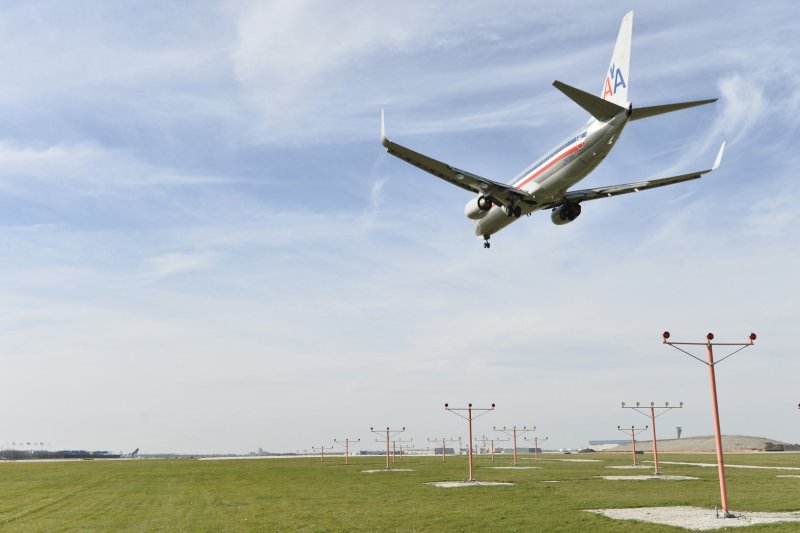A passenger jetliner lands at O'Hare International Airport in Chicago, which is one of 14 U.S. airports affected by a new federal rule that prohibits large electronic devices in the passenger cabin on flights originating from eight nations in the Middle East and Africa. File Photo by Brian Kersey/UPI |
License Photo
May 9 (UPI) -- The U.S. Department of Homeland Security may widen its seven-week-old ban that prohibits larger electronic devices as carry-on items on flights headed for the United States from high-risk countries in the Middle East and Africa.
DHS spokesman David Lapan told news media Tuesday that airlines have been advised to prepare for a possible expansion on the ban, which currently bars devices larger than smartphones from the passenger cabin on all U.S.-bound flights from eight nations in the Mideast and North Africa. Under the rule, those devices must be checked in luggage.
The March 21 regulation is aimed at airline and national security, as terrorists in the past have used electronic devices to detonate, or attempt to detonate, bombs aboard commercial jetliners.
While the larger devices can be carried onto domestic flights, they are not allowed on direct routes to the United States from 10 airports in eight countries believed by U.S. officials to pose a greater security threat -- Jordan, Saudi Arabia, Egypt, Qatar, the United Arab Emirates, Morocco, Kuwait and Turkey.
Nonstop U.S. flights from Iran, Iraq, Syria, Libya and Yemen -- other nations firmly within the "threat picture" -- do not exist.
An expansion of the ban could potentially add U.S. flights from Western Europe to the list, Lapan said.
Homeland Security Secretary John F. Kelly has previously indicated that a larger scope for the ban might be coming. The department told Fox News Monday that a final decision has not yet been made.
U.S. officials say the department is looking at expanding the rule because the higher risk zones overseas are growing.
For the last couple years, militant operatives have migrated to Western Europe specifically to carry out terrorist plots. Jihadists who might aim to strike the United States could try and skirt the electronics rule by flying from a country that's not bound by it, officials said.
When it ordered the initial ban seven weeks ago, DHS said it was motivated by "specific" and "credible" intelligence that suggested operatives may be plotting to strike U.S. targets. Last week, House Homeland Security Chairman Michael McCaul, R-Texas, reiterated that position.
"The war on terror did not end with the death of Usama bin Laden. In fact, there have been more terror plots against the West since his killing than any time since 9/11," McCaul told Fox News. "There was an imminent threat to our aviation sector and I think the administration took very responsible actions to safeguard the safety of Americans here in the homeland."
"Implementing additional security measures enhances our ability to mitigate further attempts against the overseas aviation industry," DHS said in announcing the original ban. "While a number of existing security measures remain in place, others will be modified, as deemed necessary to protect travelers."
Right now, the electronics rule affects 14 U.S. airports in New York City, Los Angeles, Chicago, Dallas, San Francisco, Seattle, Houston, Atlanta, Boston, Orlando, Philadelphia, Washington, D.C., and South Florida -- as they are the only domestic airports that currently receive the high-risk flights. Adding European countries to the list would assuredly impact more destinations in the United States.
Although widening the electronics ban would add another layer of security, experts say it would still be limited in its purpose.
An explosive device wired into a laptop computer, for example, could still make it onto any U.S.-bound flight in the luggage compartment -- a strategy terrorist operatives have utilized in the past.
Nearly 300 people died in one of the world's most notorious incidents of airline terrorism -- the 1988 bombing of Pan Am Flight 103 -- after the explosive device was checked in luggage at Pan Am's ticket counter in London. The Boeing 747, Pan Am's Clipper Maid of the Seas, was en route to New York City when the bomb -- which had been planted inside a radio -- was set off by a timer. The jetliner exploded over southern Scotland, killing 243 passengers, 16 crew and 11 on the ground.
Under current Federal Aviation Administration rules, though, checked items can be loaded into the cargo hold only if its owner is also present in the passenger cabin.















